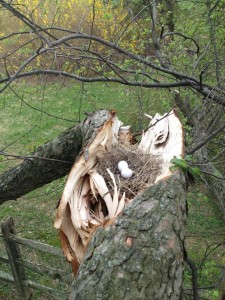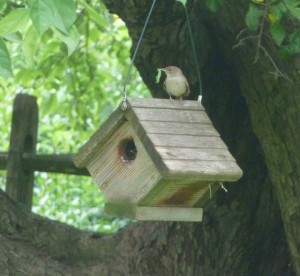By Edie Parnum
Nests are hard to find. Sure, it’s easy to see the House Wrens and Tree Swallows come and go from the nest boxes I have provided. Most songbirds, however, build and raise
their young in well-concealed cup nests. Paying particular attention to the dense areas, I examine my trees and shrubs. I look, too, for lumps in the crotches of trees. I strain to see high in the canopy. The breeding season is well underway, but I’ve found only two cup nests on my ¾-acre property.
Early this spring a female Robin built a nest out of grass, sticks, and mud in a dense holly below my raised deck. I could look down and see her settled in the nest. Once I glimpsed four pale aqua eggs. Here was an opportunity to learn more about the nesting behaviors of the American Robin. From a comfortable but hidden vantage, I planned to observe the mother robin incubate her eggs, then watch both parents feed the nestlings. Not so. One day the female and the eggs were gone.
Plenty of predators prowl around my yard. A ravenous jay, crow, raccoon, possum, snake, or even chipmunk might have devoured the eggs and destroyed the nest. Last year Gray Catbirds screeched hysterically when a Blue Jay ate their eggs.
Besides the Robin’s, a Mourning Dove’s nest was high in my in my crabapple tree this spring. While my nature-loving arborist was removing winter-damaged limbs, he exposed a flimsy nest with two eggs in the crevice of a broken branch. He left it undisturbed. From the ground I could glimpse a Mourning Dove’s eye peering at me from above the

My arborist found this Mourning Dove nest while removing winter-damaged limbs. Photo by Mark Masciangelo.
limb. Again, I hoped to watch and study the birds’ breeding routine. After a few days of viewing the brooding dove, however, I could no longer see the bird nor any activity. Why did the nest fail? Perhaps the arborist’s intrusive activity caused delayed nest abandonment. Of course, a predator could easily have seen and raided the exposed nest. Thankfully, both the doves and robins will nest again—successfully, I hope.
Besides searching for nests, I’m also watching for signs of breeding. Catbirds, cardinals, house finches, song sparrows must be breeding here. Pairs of birds, singing loudly and persistently, cavort in my yard. Some birds carry nest material. Others have insects in their beaks. When they don’t eat the food, they’re carrying it to a nest—a sure sign of breeding. I hope to discover the nest where nestlings are being fed.
Though I have not seen it, I believe a pair of Brown Thrashers has a nest on my property. Most suburban yards don’t host Brown Thrashers, especially not a breeding pair. Thrashers like dense shrubbery, not the typical manicured landscape. With their bills they sweep and probe the ground searching for insects and spiders in last year’s fallen leaves. I was plenty pleased when a Brown Thrasher spent the winter in my yard. This reddish-brown, jay-sized bird with a streaked belly stayed silent and sheltered in the arborvitae and other dense vegetation. Every few days I saw it stray from its hiding place and feed on exposed ground. I assumed it would move on in the spring to breed elsewhere.
In mid-May, a Brown Thrasher, possibly the same bird, sang vociferously from the treetops. Its loud doubled phrases are different from its close relative, the smaller Northern Mockingbird. The purpose of the song is to attract a mate and defend a breeding territory. Even so, I assumed my wintering bird (or new arrival) was just practicing and would not stay to breed here. When the singing stopped a week later, I concluded it had departed.
To my surprise in late May and June I’ve occasionally glimpsed a soundless thrasher. Males and females are indistinguishable, but sporadically I have seen two birds together. Could a pair be breeding after all? The thicket of forsythia and blackberries at the back of my property is perfect for thrashers. Every few days I spend a few minutes peering into the undergrowth and listening. Once I saw it deep, deep inside the dense vegetation. On another occasion I discerned a barely audible whisper version of the thrasher song. According to my research, thrashers are mostly silent during the nesting season but sing softly in the vicinity of a nest.
Surely thrashers have a nest in my shrubbery. It is probably just a few feet off the ground, but hidden in the impenetrable thicket. My chances of discovering it are slim. Because they consider me a potential predator, the birds probably engage in evasive behavior to lead me astray. Undeterred, I keep looking and listening.
I need a vigilant, alert ornithology student to help find the nest. A sharp-eyed young person could spot the bug in the thrasher’s beak. Together we could find the nest. See the baby birds. Watch their parents put insects into gaping mouths. Observe the naked babies grow pinfeathers followed by juvenile feathers. We would thrill to witness them fledge and take flight into the world of my backyard. Alas, without my student, I evidently can’t be a voyeur of birds’ private lives.
By searching for nests, I’ve learned more about helping breeding birds succeed. I’ll plant more dense shrubs where birds can build and protect their nests. These shrubs will be insect-hosting natives instead of the non-native forsythia. Already I do not tidy up the thickets and corners of the yard. Thrashers and other ground-feeding birds require the leaf litter to feed themselves and their offspring. Next fall I’ll welcome leaves into the perennial beds, too. And, most important, I’ll grow more native plants where birds can find plentiful insects to feed their young.
In some ways I’m unable to help and must trust the birds’ own survival abilities. Predators abound, but the birds possess skills to protect their nests, eggs, and nestlings. Vigilant and ingenious, they know how to keep their nest locations secret. Thankfully, when a nest fails, most are able to produce a second brood.
It’s summer now, and I see lots of baby birds around the yard. The nests are somewhere nearby. Birds are breeding here successfully.


